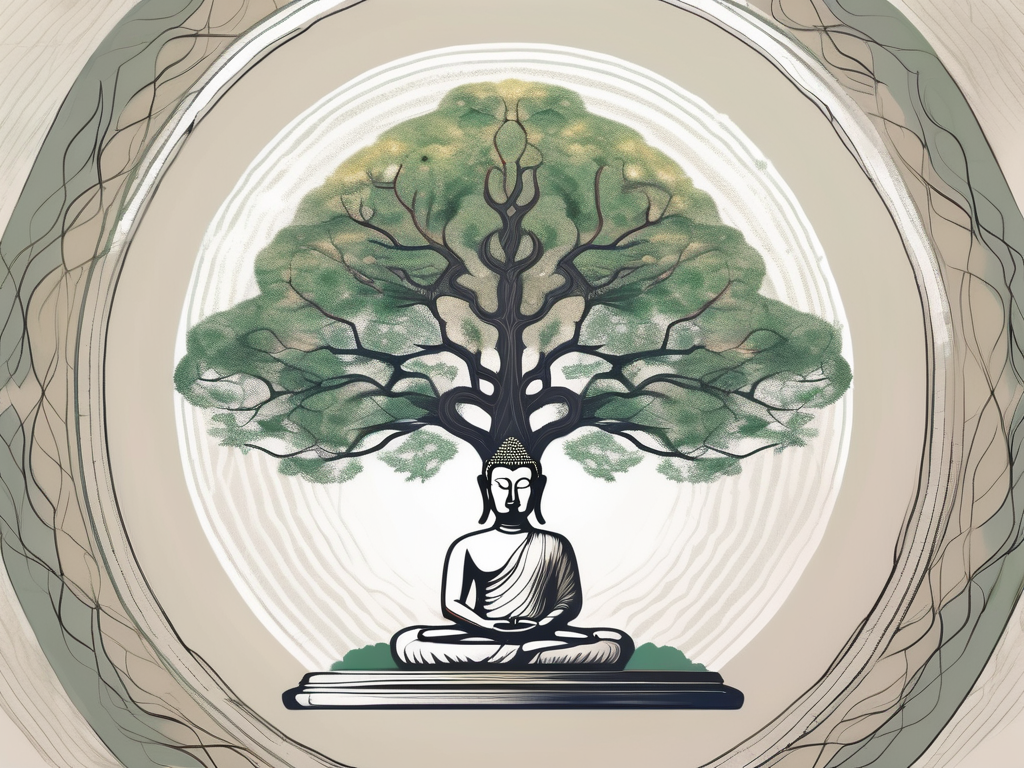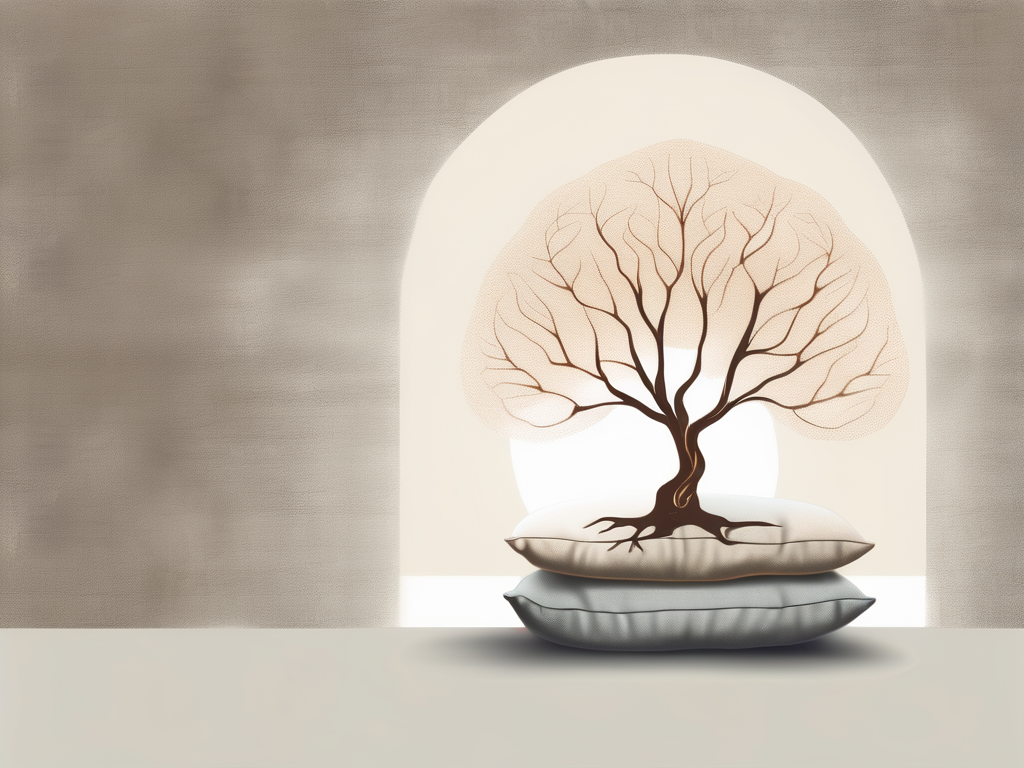Buddhism, one of the world’s major religions, traces its roots back to the teachings of a man named Siddhartha Gautama, commonly known as the Buddha. His life and teachings have had a profound impact on millions of people around the world. In this comprehensive guide, we will explore the life of Buddha and delve deep into his profound teachings.
Understanding Siddhartha Gautama: The Man Before Buddha
Before becoming the Buddha, Siddhartha Gautama led an extraordinary life filled with deep contemplation and spiritual exploration. Born into a noble family in ancient India, Siddhartha lived a life of comfort and privilege. However, he was not immune to the sufferings of the world.
The Early Life of Siddhartha Gautama
Siddhartha’s journey began in the kingdom of Kapilavastu, where he was sheltered and shielded from the harsh realities of life. Surrounded by opulence and luxury, he grew up in a palace adorned with exquisite tapestries and gardens blooming with vibrant flowers. His days were filled with music, dance, and intellectual pursuits, as he received the finest education from renowned scholars.
Yet, despite the lavish lifestyle, Siddhartha’s heart yearned for something more. He often found himself gazing out of the palace windows, wondering about the world beyond. It was during one of these moments that fate intervened, leading him on a path that would forever change his life.
As he ventured beyond the palace walls, Siddhartha encountered aging, sickness, and death, which deeply disturbed him. The sight of a frail old man struggling to walk, a sick person writhing in pain, and a lifeless body being carried to the funeral pyre left an indelible mark on his soul. These encounters shattered the illusion of eternal youth and invincibility that had surrounded him, awakening a profound sense of empathy and compassion.
The Great Renunciation: Siddhartha’s Quest for Enlightenment
Driven by a burning desire to find answers, Siddhartha decided to renounce his comfortable life and seek spiritual enlightenment. Leaving behind his wife, Princess Yasodhara, and their newborn son, Rahula, he set out on a journey that would take him far from the comforts of the palace.
Wandering through dense forests, Siddhartha immersed himself in the solitude of nature. He sought the wisdom of ascetics and holy men, engaging in rigorous practices of self-denial and meditation. Yet, despite his unwavering determination, none of these teachings satisfied his quest for true wisdom.
Undeterred, Siddhartha continued his search, delving deeper into the realms of consciousness and self-discovery. He subjected himself to extreme fasting and endured long periods of meditation, pushing the limits of his physical and mental endurance. Through these arduous trials, Siddhartha sought to unravel the mysteries of existence and find a path to liberation.
As the days turned into weeks and the weeks into months, Siddhartha’s perseverance paid off. One fateful night, while sitting beneath the Bodhi tree, he experienced a profound awakening. The veil of ignorance was lifted, and Siddhartha Gautama became the Buddha, the enlightened one.
From that moment on, Siddhartha dedicated his life to teaching others the path to enlightenment, spreading his message of compassion, mindfulness, and liberation from suffering. His teachings, known as Buddhism, continue to inspire millions around the world, offering a profound understanding of the human condition and a roadmap to inner peace.
The Birth of Buddha: The Path to Enlightenment
After years of intense exploration, Siddhartha finally discovered enlightenment under a Bodhi tree, becoming the Buddha, which means “the awakened one.” This momentous event marked a turning point in his life and paved the way for his teachings to transform the world.
The journey to enlightenment was not an easy one for Siddhartha. He had spent years wandering the forests and mountains, seeking answers to life’s deepest questions. He studied under various spiritual teachers, learning different philosophies and practices. Yet, none of them provided him with the ultimate truth he sought.
It was during a period of deep meditation that Siddhartha experienced a profound realization. He understood that the key to liberation from suffering lay within his own mind. This insight ignited a fire within him, propelling him to continue his quest for enlightenment.
Under the shade of the Bodhi tree, Siddhartha engaged in rigorous meditation and contemplation. He faced numerous challenges and temptations along the way, but he remained steadfast in his pursuit of truth. Finally, after days of unwavering dedication, he achieved the state of enlightenment.
The moment Siddhartha became the Buddha was not just a personal triumph; it was a breakthrough for humanity. The teachings that emerged from his enlightenment would go on to inspire countless individuals throughout history, offering them a path to liberation and inner peace.
The Four Noble Truths: Buddha’s Core Teachings
Central to Buddha’s teachings are the Four Noble Truths, which encapsulate the essence of human suffering and its possible cessation. These truths teach us that suffering is an inherent part of life, primarily caused by our desires and attachments. However, through understanding and embracing these truths, liberation from suffering becomes attainable.
The First Noble Truth acknowledges the existence of suffering. It reminds us that life is filled with various forms of pain, including physical, emotional, and mental suffering. Siddhartha recognized that denying or avoiding suffering only perpetuates our discontentment.
The Second Noble Truth reveals the cause of suffering: our desires and attachments. Siddhartha understood that our incessant craving for pleasure and aversion to pain create an endless cycle of dissatisfaction. By recognizing and letting go of these attachments, we can free ourselves from suffering.
The Third Noble Truth offers hope by proclaiming the cessation of suffering. Siddhartha realized that liberation from suffering is possible through the eradication of desires and attachments. This truth serves as a guiding light, inspiring individuals to embark on the path towards enlightenment.
The Fourth Noble Truth outlines the Eightfold Path, which provides a practical roadmap for achieving liberation from suffering. It is through the diligent practice of this path that individuals can transform their lives and experience true happiness.
The Eightfold Path: Buddha’s Guide to Spiritual Awakening
Complementing the Four Noble Truths is the Eightfold Path, offering a practical and comprehensive guide to attaining enlightenment. This path advocates for moral conduct, mindfulness, and developing wisdom. By following the Eightfold Path, individuals can cultivate a balanced and compassionate existence.
The first aspect of the Eightfold Path is Right View, which involves understanding the nature of reality and the Four Noble Truths. It requires us to see things as they truly are, without delusion or distortion.
Right Intention is the second aspect of the path, emphasizing the importance of cultivating wholesome intentions and letting go of harmful desires. It encourages us to act with kindness, compassion, and wisdom.
Right Speech, the third aspect, highlights the significance of using our words mindfully and truthfully. It encourages us to avoid harmful speech, such as lying, gossiping, or using harsh language, and instead promotes speech that is beneficial and uplifting.
Right Action focuses on ethical conduct and encourages us to engage in actions that promote well-being and avoid actions that cause harm. It encompasses principles such as refraining from killing, stealing, and engaging in sexual misconduct.
Right Livelihood emphasizes the importance of earning a living in a way that is ethical and aligned with one’s values. It encourages individuals to choose occupations that do not cause harm to others or contribute to their suffering.
Right Effort involves cultivating wholesome qualities and abandoning unwholesome ones. It requires us to make a sustained effort to develop positive qualities such as mindfulness, compassion, and generosity, while letting go of negative traits like greed, hatred, and ignorance.
Right Mindfulness is the seventh aspect of the path and involves cultivating a clear and non-judgmental awareness of the present moment. It encourages us to observe our thoughts, feelings, and sensations without attachment or aversion.
Finally, Right Concentration focuses on developing deep states of concentration through meditation. It involves training the mind to become calm, focused, and free from distractions, leading to profound insights and spiritual awakening.
By following the Eightfold Path, individuals can gradually transform their lives, aligning their thoughts, words, and actions with wisdom and compassion. This path serves as a roadmap to spiritual awakening, guiding practitioners towards the ultimate goal of liberation from suffering.
The Teachings of Buddha: A Deep Dive
Buddha’s teachings go beyond the mere alleviation of personal suffering; they encompass a profound understanding of the human condition and the nature of reality. Two fundamental concepts in Buddhism are Karma and Anatta.
The Concept of Karma in Buddhism
Karma, a concept deeply ingrained in Buddhist philosophy, elucidates the relationship between actions and their consequences. It emphasizes the interconnectedness of all beings and encourages individuals to cultivate positive actions to create a harmonious world.
According to the teachings of Buddha, every action, whether physical, verbal, or mental, has consequences. These consequences, known as karma, shape the course of an individual’s life and determine their future experiences. Karma is not a form of punishment or reward; rather, it is a natural law that operates in accordance with cause and effect.
When one performs wholesome actions, such as acts of kindness, generosity, and compassion, they create positive karma. This positive karma not only benefits the individual but also contributes to the well-being of others and the world as a whole. On the other hand, unwholesome actions, such as greed, hatred, and ignorance, generate negative karma, leading to suffering and disharmony.
Understanding and acknowledging the concept of karma empowers individuals to take responsibility for their actions and the impact they have on themselves and others. It encourages them to cultivate virtues and engage in actions that promote peace, harmony, and well-being.
Understanding Anatta: The Buddhist Doctrine of ‘No-Self’
Anatta challenges the notion of a fixed and permanent self and instead emphasizes the impermanence and interconnectedness of all things. It liberates individuals from the burdens of self-identification and attachments, enabling them to experience true freedom and liberation.
In Buddhism, the concept of anatta is a profound teaching that challenges the conventional understanding of a permanent and unchanging self. According to Buddha, there is no inherent or independent self that exists separate from the ever-changing nature of existence.
Instead of identifying with a fixed self, Buddhism teaches that individuals are a combination of ever-changing physical and mental processes. These processes are influenced by various factors, including genetics, environment, and past experiences. The idea of anatta invites individuals to investigate and observe their experiences without clinging to a fixed identity.
By recognizing the impermanence and interconnectedness of all things, individuals can free themselves from the suffering caused by attachment and self-identification. This liberation allows for a deeper understanding of reality and the experience of true freedom and liberation.
Practicing anatta involves cultivating mindfulness and developing insight into the nature of existence. It encourages individuals to let go of the illusion of a separate self and embrace the interconnectedness of all beings. By doing so, one can experience a profound sense of interconnectedness, compassion, and liberation.
Buddha’s Influence: The Spread of Buddhism
Following Buddha’s enlightenment, he shared his teachings with anyone willing to listen. His disciples carried his message far and wide, which led to the establishment of vibrant Buddhist communities and monastic traditions.
The First Buddhist Council: Preserving Buddha’s Teachings
Soon after Buddha’s passing, a council was convened to preserve and codify his teachings. During this gathering, his disciples recited and transcribed his words, ensuring that future generations would have access to his profound wisdom.
Buddhism Beyond India: The Spread to East Asia and Beyond
In the centuries that followed, Buddhism spread throughout Asia, making its way to countries like China, Japan, Korea, and Tibet. Each of these regions imbued the teachings with their unique cultural expressions, resulting in various Buddhist traditions that continue to flourish today.
The Legacy of Buddha: Impact on Modern Society
Buddha’s teachings have transcended time and geography, leaving an indelible mark on the world. His wisdom continues to resonate with people across diverse cultures and societies, offering profound insights and guidance in the modern era.
Buddhism in Contemporary Culture
In today’s fast-paced and interconnected world, Buddhism has found its place in diverse cultural landscapes. Mindfulness practices, derived from Buddhist meditation, have gained immense popularity as tools for stress reduction, personal growth, and maintaining overall well-being.
The Relevance of Buddha’s Teachings in the 21st Century
Amidst ongoing challenges and uncertainties, Buddha’s teachings remain relevant and offer invaluable guidance. They provide us with insights into cultivating compassion, living in harmony with nature, and finding inner peace in the midst of chaos.
In conclusion, the life and teachings of Buddha hold immense significance for individuals seeking a deeper understanding of existence and a path towards liberation. By exploring his life’s journey and delving into his profound teachings, we can gain invaluable insights that have the potential to transform our lives and create a more harmonious world.












